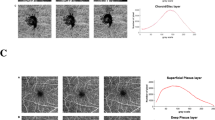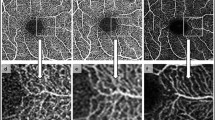Abstract
Purpose
To examine the effects of enhanced depth imaging (EDI) and en face averaging on global vascular measurements of optical coherence tomography angiography (OCTA) images.
Methods
All eyes were imaged with 3 mm × 3 mm fields centered at the fovea using the Carl Zeiss Cirrus 5000 spectral-domain OCTA, with and without EDI, and the Zeiss PLEX Elite 9000 swept-source OCTA. Vessel area density (VAD), vessel length (VL), and vessel diameter index (VDI) were calculated for the superficial capillary plexus (SCP) en face angiograms. For the choriocapillaris (CC), VAD and the number, total area, and average size of flow voids were calculated. These metrics were compared between SD- and SS-OCTA images, with and without en face averaging and EDI.
Results
Both averaging and EDI had a significant effect on quantitative metrics. EDI images trended toward a decrease in SCP VAD. In the CC, EDI decreased average flow void size. Averaging increased CC VAD while decreasing number of flow voids, total flow void area, and average flow void size. With both averaging and EDI, SD-OCTA was not able to visualize as many CC flow voids, particularly of a smaller size, compared with SS-OCTA.
Conclusions
Averaging and EDI affect quantitative metrics from SCP and CC OCTA images. EDI resulted in a trend toward decreased VAD in SCP images. Averaging had a major effect on CC imaging. Even with the combination of EDI and en face averaging, SD-OCTA images do not appear to approximate SS-OCTA images in terms of quantitative metrics. This has implications for clinical and research use of SD-OCTA for retinal imaging.




Similar content being viewed by others
References
Spaide RF, Fujimoto JG, Waheed NK, Sadda SR, Staurenghi G (2018) Optical coherence tomography angiography. Prog Retin Eye Res 64:1–55. https://doi.org/10.1016/j.preteyeres.2017.11.003
de Carlo TE, Salz DA, Waheed NK, Baumal CR, Duker JS, Witkin AJ (2015) Visualization of the retinal vasculature using wide-field montage optical coherence tomography angiography. Ophthalmic Surg Lasers Imaging Retina 46(6):611–616. https://doi.org/10.3928/23258160-20150610-03
Ferrara D, Waheed NK, Duker JS (2016) Investigating the choriocapillaris and choroidal vasculature with new optical coherence tomography technologies. Prog Retin Eye Res 52:130–155. https://doi.org/10.1016/j.preteyeres.2015.10.002
Cao J, McLeod S, Merges CA, Lutty GA (1998) Choriocapillaris degeneration and related pathologic changes in human diabetic eyes. Arch Ophthalmol 116(5):589–597
Lutty G, Grunwald J, Majji AB, Uyama M, Yoneya S (1999) Changes in choriocapillaris and retinal pigment epithelium in age-related macular degeneration. Mol Vis 5:35
Spaide RF (2009) Age-related choroidal atrophy. Am J Ophthalmol 147(5):801–810. https://doi.org/10.1016/j.ajo.2008.12.010
Chang AA, Morse LS, Handa JT, Morales RB, Tucker R, Hjelmeland L, Yannuzzi LA (1998) Histologic localization of indocyanine green dye in aging primate and human ocular tissues with clinical angiographic correlation. Ophthalmology 105(6):1060–1068. https://doi.org/10.1016/S0161-6420(98)96008-0
Wong IY, Koizumi H, Lai WW (2011) Enhanced depth imaging optical coherence tomography. Ophthalmic Surg Lasers Imaging 42(Suppl):S75–S84. https://doi.org/10.3928/15428877-20110627-07
Ferrara D, Mohler KJ, Waheed N, Adhi M, Liu JJ, Grulkowski I, Kraus MF, Baumal C, Hornegger J, Fujimoto JG, Duker JS (2014) En face enhanced-depth swept-source optical coherence tomography features of chronic central serous chorioretinopathy. Ophthalmology 121(3):719–726. https://doi.org/10.1016/j.ophtha.2013.10.014
Spaide RF, Koizumi H, Pozzoni MC (2008) Enhanced depth imaging spectral-domain optical coherence tomography. Am J Ophthalmol 146(4):496–500. https://doi.org/10.1016/j.ajo.2008.05.032
Sander B, Larsen M, Thrane L, Hougaard JL, Jorgensen TM (2005) Enhanced optical coherence tomography imaging by multiple scan averaging. Br J Ophthalmol 89(2):207–212. https://doi.org/10.1136/bjo.2004.045989
Sakamoto A, Hangai M, Yoshimura N (2008) Spectral-domain optical coherence tomography with multiple B-scan averaging for enhanced imaging of retinal diseases. Ophthalmology 115(6):1071–1078 e1077. https://doi.org/10.1016/j.ophtha.2007.09.001
Uji A, Balasubramanian S, Lei J, Baghdasaryan E, Al-Sheikh M, Sadda SR (2017) Impact of multiple en face image averaging on quantitative assessment from optical coherence tomography angiography images. Ophthalmology 124(7):944–952. https://doi.org/10.1016/j.ophtha.2017.02.006
Spaide RF (2016) Choriocapillaris flow features follow a power law distribution: implications for characterization and mechanisms of disease progression. Am J Ophthalmol 170:58–67. https://doi.org/10.1016/j.ajo.2016.07.023
Tang FY, Ng DS, Lam A, Luk F, Wong R, Chan C, Mohamed S, Fong A, Lok J, Tso T, Lai F, Brelen M, Wong TY, Tham CC, Cheung CY (2017) Determinants of quantitative optical coherence tomography angiography metrics in patients with diabetes. Sci Rep 7(1):2575. https://doi.org/10.1038/s41598-017-02767-0
Mehta N, Liu K, Alibhai AY, Gendelman I, Braun P, Ishibazawa A, Sorour O, Duker JS, Waheed NK (2019) Impact of binarization thresholding and brightness/contrast adjustment methodology on optical coherence tomography angiography image quantification. Am J Ophthalmol. https://doi.org/10.1016/j.ajo.2019.03.008
Waheed NK, Duker JS (2017) Image averaging, a powerful tool in optical coherence tomography and optical coherence tomography angiography. JAMA Ophthalmol 135(11):1204–1205. https://doi.org/10.1001/jamaophthalmol.2017.4015
Carrasco-Zevallos O, Moult E, Alibhai AY, Lee B, Chen S, Mehta N, Potsaid B, Jayaraman V, Cable A, Waheed NK, Fujimoto JG (2019) 4D OCTA: time-resolved OCTA to image chorioretinal hemodynamics in the human eye. Invest Ophthalmol Vis Sci 60(9):3277–3277
Funding
This work was financially supported by the Macula Vision Research Foundation (West Conshohocken, PA, USA), the Massachusetts Lions Clubs (Belmont, MA, USA), the National Institutes of Health (Bethesda, MD, USA; grant number 5-R01-EY011289-31), the Air Force Office of Scientific Research (Arlington, VA, USA; grant number FA9550-15-1-0473), and the Champalimaud Vision Award (Lisbon, Portugal), the Beckman-Argyros Award in Vision Research (Irvine, CA, USA).
Author information
Authors and Affiliations
Corresponding author
Ethics declarations
Conflict of interest
Dr. Ishibazawa reports personal fees from Topcon Corporation, outside the submitted work. Dr. Baumal reports personal fees from Carl Zeiss Meditec, and personal fees from Optovue, outside the submitted work. Dr. Duker reports grants from Carl Zeiss Meditech, grants from Optovue, is a consultant for Allegro, is a consultant for Allergan, is a consultant for Aura Biosciences, is a consultant for Beyeonics, is a consultant for Helio Vision, is a consultant for Novartis, is a consultant for Roche, is a consultant for Santen, is a consultant for Sigilon, is a consultant for Hemera Biosciences, is a consultant for Sesen BIO, and is a consultant for Eyepoint Pharma, outside the submitted work. Dr. Sadda reports personal fees from Genentech, personal fees from Allergan, personal fees from Novartis, personal fees from 4DMT, personal fees from Oxurion, grants and personal fees from Optos, personal fees from Heidelberg, grants from Carl Zeiss Meditec, personal fees from Centervue, personal fees from Topcon, and personal fees from Amgen, outside the submitted work. Dr. Waheed reports personal fees and non-financial support from Nidek Medical Products, non-financial support from Carl Zeiss Meditec, grants from Macula Vision Research Foundation, personal fees from Topcon Corporation, personal fees from Optovue, personal fees from Heidelberg Engineering, grants from Massachusetts Lions Club, and grants from Beckman-Argyros Award in Vision Research, outside the submitted work. No disclosures exist for the remaining authors.
Ethics approval
All procedures performed in studies involving human participants were in accordance with the ethical standards of the Tufts Medical Center Institutional Review Board and with the 1964 Helsinki declaration and its later amendments or comparable ethical standards.
Informed consent
Informed consent was obtained from all individual participants included in the study.
Additional information
Publisher’s note
Springer Nature remains neutral with regard to jurisdictional claims in published maps and institutional affiliations.
Rights and permissions
About this article
Cite this article
Liu, K., Mehta, N., Alibhai, A.Y. et al. Effects of enhanced depth imaging and en face averaging on optical coherence tomography angiography image quantification. Graefes Arch Clin Exp Ophthalmol 258, 979–986 (2020). https://doi.org/10.1007/s00417-020-04610-1
Received:
Revised:
Accepted:
Published:
Issue Date:
DOI: https://doi.org/10.1007/s00417-020-04610-1




